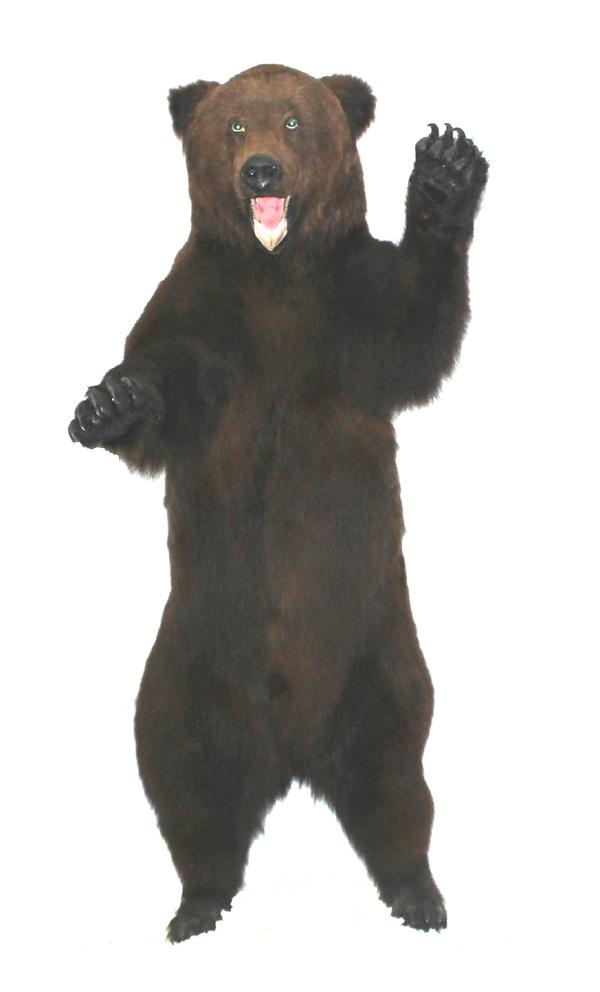Bears as a species first emerged on the planet some 5-6 million years ago. Bears belong to the Ursidae mammalian family. Brown bears are endemic to boreal forests. Brown bears can be found practically across all of Russia, but they are especially common in Siberia and the Far East. Brown bears can be as tall as 160cm from the paw to the top of the back. The body length varies between 1.6 and 2.0 meters; the weight can be as much as 350 kg.
Bears are smart, fast, dexterous, and cunning, and from times immemorial, the bear has been regarded as a symbol of power and strength as it is the largest carnivore on Earth. However, bears do not often hunt: they will normally be wandering through the forest from dawn till dusk looking for food, digging up roots, digging through anthills, or chewing on fallen leaves. Bears are especially fond of raspberries and honey, a bear can hear the buzzing of bees from several kilometers away. A bear’s menu also includes insects, worms, lizards, frogs, rodents, and fish.
Brown bears have an average lifespan of up to 40 years. During the winter, when little food can be scavenged, a bear will dig out a den under some tree roots, climb in there for the winter. Over this period, the bear will live off the fat it will have accumulated in the fall. Bears do not really hibernate. They can easily wake up, climb out of the den, and wander around even in winter. When an adult bear encounters an adult human, it will normally try to hide. But bears that wake up during the winter can pose a major threat to people and animals and even to other bears.
Up until the late 19th century, brown bears were very common in the territory of the Samara Governorate and especially in the territory of the Samara Luka national park. The last brown bear was only killed in the 1900s. Several years ago, the officials of the national park were considering bringing bears back to their former habitat. The plan was to bring several bears to territories closed to tourists, the Shelekhmetsky and Charokaevsky forests; however, the project never got off the ground.
Syzran’s Museum of Local History and Lore exhibits a stuffed brown bear standing on hind legs. The 180-centimeter-tall example is a Siberian brown bear. The museum acquired the stuffed animal in 2009; it had been made by the experts of the Zoology Museum of the Samara Academy of the Humanities.
Bears are smart, fast, dexterous, and cunning, and from times immemorial, the bear has been regarded as a symbol of power and strength as it is the largest carnivore on Earth. However, bears do not often hunt: they will normally be wandering through the forest from dawn till dusk looking for food, digging up roots, digging through anthills, or chewing on fallen leaves. Bears are especially fond of raspberries and honey, a bear can hear the buzzing of bees from several kilometers away. A bear’s menu also includes insects, worms, lizards, frogs, rodents, and fish.
Brown bears have an average lifespan of up to 40 years. During the winter, when little food can be scavenged, a bear will dig out a den under some tree roots, climb in there for the winter. Over this period, the bear will live off the fat it will have accumulated in the fall. Bears do not really hibernate. They can easily wake up, climb out of the den, and wander around even in winter. When an adult bear encounters an adult human, it will normally try to hide. But bears that wake up during the winter can pose a major threat to people and animals and even to other bears.
Up until the late 19th century, brown bears were very common in the territory of the Samara Governorate and especially in the territory of the Samara Luka national park. The last brown bear was only killed in the 1900s. Several years ago, the officials of the national park were considering bringing bears back to their former habitat. The plan was to bring several bears to territories closed to tourists, the Shelekhmetsky and Charokaevsky forests; however, the project never got off the ground.
Syzran’s Museum of Local History and Lore exhibits a stuffed brown bear standing on hind legs. The 180-centimeter-tall example is a Siberian brown bear. The museum acquired the stuffed animal in 2009; it had been made by the experts of the Zoology Museum of the Samara Academy of the Humanities.



